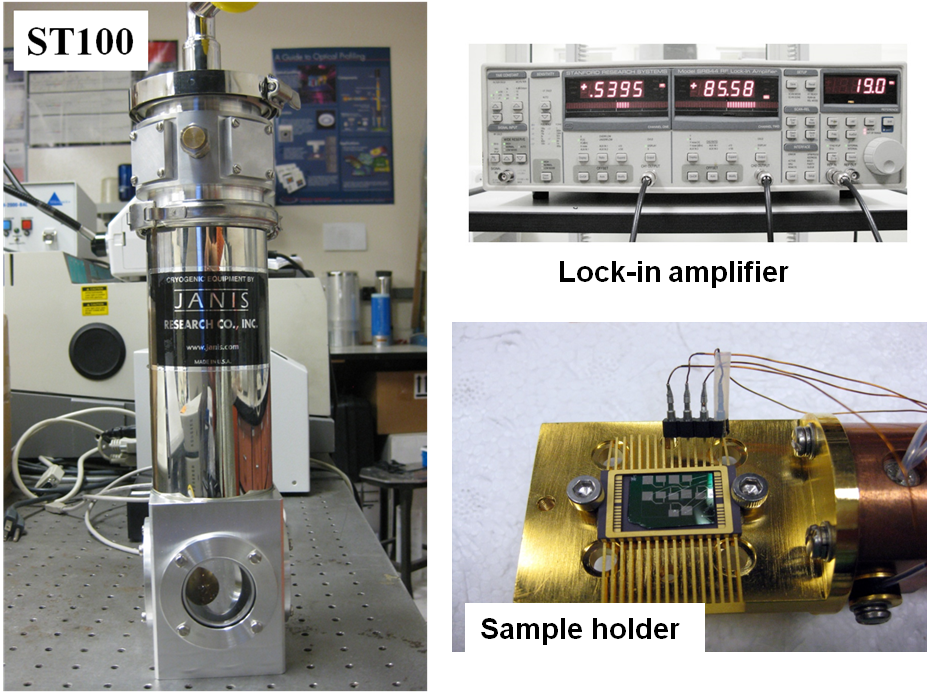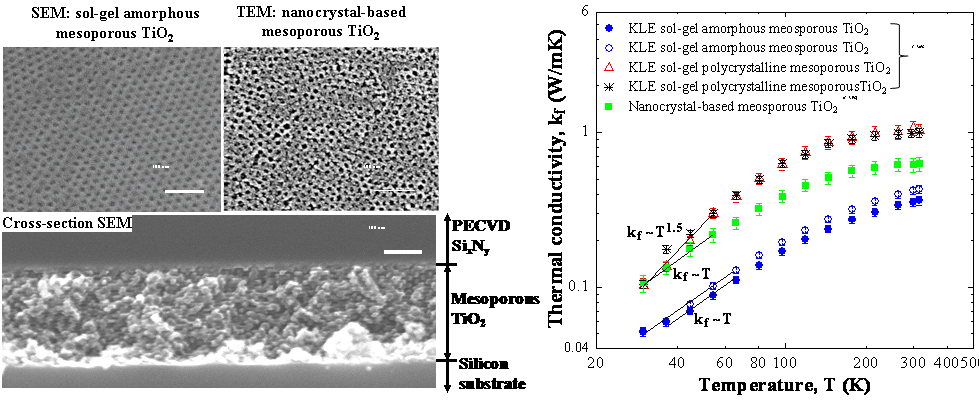Motivations
Mesoporous titania (TiO2) thin films have been considered for energy storage applications such as accumulators and electrochemical capacitors. They are also used as electrodes in dye-sensitized solar cells and as high proton conductivity porous exchange membranes in solid oxide fuel cells. Moreover, Choi et al. identified mesoporous TiO2 thin films as promising thermal insulating materials for infrared sensors. Finally, other applications include (i) highly specific chemical sensors and membranes, (ii) photocatalyst for water and air purification, and (iii) optical coatings, emissive displays, and optoelectronics.
Knowledge of thermal properties of mesoporous titania thin films is essential to their practical implementation into devices. The present study aims to (i) measure the effective cross-plane thermal conductivity of mesoporous TiO2 thin films with various nanoscale architectures and (ii) investigate the effects of temperature, presence of pores, and crystallinity of the TiO2 matrix over the temperature range from 30 to 320 K.
Samples

Setup
The cross-plane thermal conductivity of highly-ordered amorphous and crystalline templated mesoporous titania thin films was measured by the 3ω method from 30 to 320K.


Results

Conclusion
-
The thermal conductivity of sol-gel derived TiO2 thin films increased with increasing temperature. For amorphous and polycrystalline mesoporous TiO2 thin films, conductivity at low temperatures was proportional to T and T1.5, respectively, as opposed to T2 for the corresponding non-templated (dense) films.
-
The Cahill-Pohl model for highly disordered materials captured the temperature dependence of the thermal conductivity of dense amorphous and polycrystalline TiO2 thin films for T>120 K.
-
The sol-gel amorphous mesoporous TiO2 thin films had thermal conductivity less than half of that of their dense counterpart. The thermal conductivity of amorphous dense and mesoporous films had similar temperature dependence for T>60 K. This was due to the fact that the presence of the pores only reduces the cross-sectional area for heat transport without affecting the localized vibrational modes.
-
The thermal conductivity of sol-gel polycrystalline mesoporous TiO2 thin films was three times smaller than that of their dense counterpart. This was mainly due to phonon scattering by pores and smaller crystalline domains (12-13 nm versus 30 nm). The thermal conductivity of polycrystalline dense and mesoporous films had different temperature dependence suggesting that the presence of the pores also affect the phonon dispersion and density of state in the polycrystalline matrix.
-
The NC-based mesoporous TiO2film had thermal conductivity about 40% less than that of the polycrystalline mesoporous films and two times larger than that of the amorphous mesoporous films. This was attributed to its particles' crystallinity with smaller crystal size (~9 nm), larger porosity (35%), and poor connections between individual anatase nanocrystals.
Publications
J. Fang, C. Kang, Y. Huang, S.H. Tolbert, and L. Pilon, 2012. Thermal Conductivity of Ordered Mesoporous Nanocrystalline Silicon Thin Films Made from Magnesium Reduction of Polymer-Templated Silica. Journal of Physical Chemistry C, Vol. 116, No. 23, pp. 12926–12933. doi: 10.1021/jp302531d pdf
J. Fang, C. Reitz, T. Brezesinski , E. J. Nemanick, C.B. Kang, S.H. Tolbert, and L. Pilon, 2011. Thermal Conductivity of Amorphous and Crystalline Mesoporous Titania Thin Films from 30 to 320 K. The Journal of Physical Chemistry C, Vol. 115, No. 30, pp 14606–14614. doi:10.1021/jp203400t pdf
T. Coquil, C. Reitz, T. Brezesinski , E. J. Nemanick, S.H. Tolbert, and L. Pilon, 2010. Thermal Conductivity of Mesoporous Titania Films Made From Nanocrystalline Building Blocks and Sol-Gel Reagents, The Journal of Physical Chemistry C, Vol. 114, no. 29, pp 12451–12458. doi:10.1021/jp103251t pdf
T. Coquil, E. Richman, N. Hutchinson, S. Tolbert, and L. Pilon, 2009. Thermal Conductivity of Cubic and Hexagonal Mesoporous Silica Thin Films, Journal of Applied Physics, Vol. 106, no.3, 034910. Selected to appear in Virtual Journal of Nanoscale Science & Technology, Vol. 20, no.8, August 24, 2009. doi:10.1063/1.3182826 pdf
Data Downloads